Regional Arts Fellowship - Field Report 4 [UK/Belgium/Sweden/Japan/NSW]
Included in this post is a look at some creative outcomes for my 2017 fellowship activities in UK/Belgium/Sweden/Japan/Regional NSW => Gigs at Cafe OTO, Trap Club, FUSE Art Space, SuperDeluxe. Chris Watson, Jez riley French and Aphex Twin mentorships, residencies at University of Hull, University of Newcastle, EMS Stockholm + a visit to ALM Busy Circuits, and Roland's Artist Liason Centre in Tokyo, and working in the field and in the studio in regional NSW for preparation of my Rainwire [Processed] installation.
This is the fourth post on my Create NSW Regional Arts Fellowship, you can check out the first post on a week spent with Chris Watson here, the second post on my Moog Sound Lab UK Residency here and the third post on my EMS Stockholm Residency here. During the trips I posted up a whole bunch of pictures/tweets live through my twitter account, so you can also have a look back through those tweets too 
* UPDATE => PART 5 NOW ONLINE HERE *
Following on from my first EMS residency I hopped on a plane to London for a gig at Cafe OTO and a slot on Graham Dunning's Fractal Meat on a Spongy Bone Radio Show, which you can check out in my previous posts & at the bottom of this post. I was on a tight budget and Andie Brown kindly put me up, helped me out in general, gave me directions and fed me in London! Also a quick shout out to Phil Julian for setting me up with this gig and intro'ing me to Andie Brown and Graham Dunning!
 |
| At the NTS Radio studio, photo Graham Dunning |
 |
| My little sofa/bed setup at Andie Brown's London gaff |
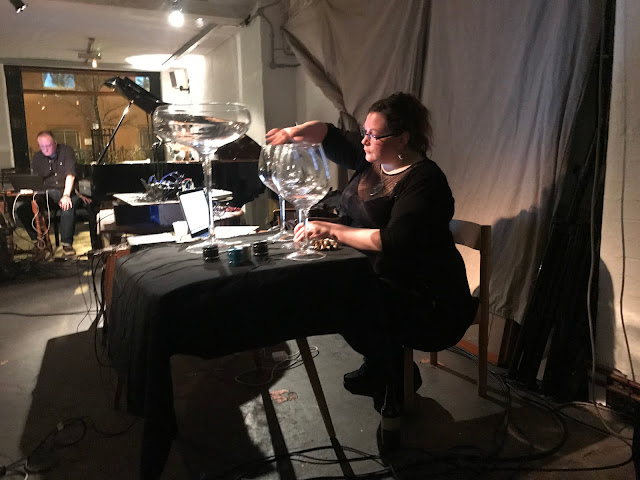 |
| Andie Brown & Phil Julian performing at Cafe OTO |
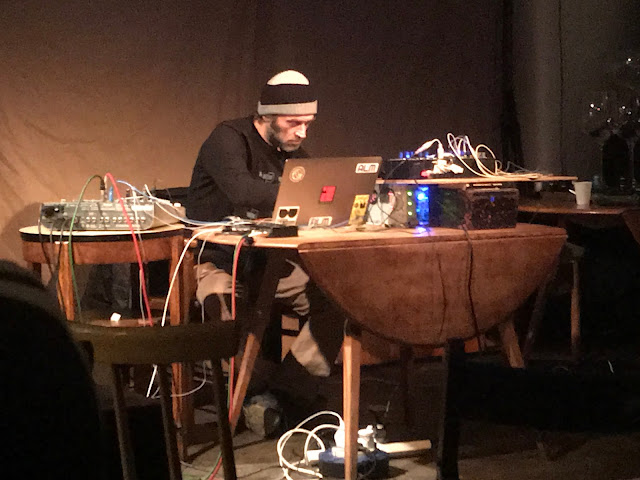 |
| Performing at Cafe OTO |
After this little stint in London I was on the early train to Antwerp for a gig at the Trap Club with Entr'acte to promote the then upcoming dual CD releases FLD RCDR / MCRTNL.
After Antwerp I was whisked off to a secret Scottish location for a couple of weeks of mentorship with Richard D James. During this time I worked on a number of interesting pieces of gear, such as the Cirklon, PreenFM2 and a bunch of Eurorack modules.
 |
| Aphex Twin, courtesy Richard D James |
I also saw early on the custom microtuning to pitchbend converter box for his Korg Minilogue, later mentioned in this interview with Tatsuya Takahashi.
 |
| Microtuning to pitchbend converter, photo Dave Burraston |
 |
| Checking out a Cirklon front panel, photo Richard D James |
 |
| Getting ready for a microtonal discussion, photo Richard D James |
A key part of the mentorship was the chance to work on his Fairlight CMI Series 1 sound sampler. I used this for manipulating and resynthesizing some of my Rainwire samples for an upcoming installation at University of Hull. The process for this was pretty straightforward after I'd had a few days training and self directed exploration. I setup my laptop to play the soundfiles from my MOTU interface direct into the mono input on the Fairlight. Once I had a few sections recorded and stored on the Fairlight's disc drive I could go about resynthesizing / processing them. Then I set about playing them direct from the huge keyboard and my MANIAC cellular automata sequencer, using various microtonal tunings. The sound quality is really quite something for an 8bit machine! I recorded the Fairlight output direct into my Zoom F8 field recorder.
Other activities with Richard included washing up, tidying up, helping out in the workshop, moving equipment, making up some cables and soldering them to a very obscure AKG spring reverb.. These sorts of things are a key part of any working artist/musicians life and it was good experience to spend the time on these less glamorous activities..  Richard was also very keen for me to be actively involved in the Cirklon and PreenFM2 communities, so he said "i might as well just give you one of each, and you can get on with it asap.." So he dug out a couple of bust ups, a Cirklon with a smashed off data encoder, and a chipped up PreenFM2, wowsers! thanks m8y! I got Finlay Shakespeare to fix the bust up encoder, and he did a great job on it. Here's a couple of pics of these setup in my studio =>
Richard was also very keen for me to be actively involved in the Cirklon and PreenFM2 communities, so he said "i might as well just give you one of each, and you can get on with it asap.." So he dug out a couple of bust ups, a Cirklon with a smashed off data encoder, and a chipped up PreenFM2, wowsers! thanks m8y! I got Finlay Shakespeare to fix the bust up encoder, and he did a great job on it. Here's a couple of pics of these setup in my studio =>
 |
| Cirklon hardware sequencer |
 |
| PreenFM2 synthesizer |
Next up in my programme was a mentorship with Jez riley French. This kicked off with a gig at Fuse Art Space, Bradford with Jez and Embla Quickbeem. For this performance I worked with material recorded at EMS & material recorded from Richard's Fairlight, along with live improvisation with my Eurorack modular and MANIAC cellular automata sequencer.
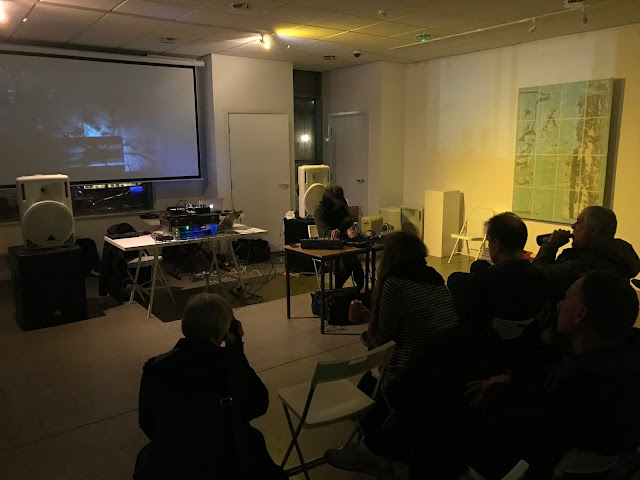 |
| Embla Quickbeem performance at Fuse Art Space, Bradford |
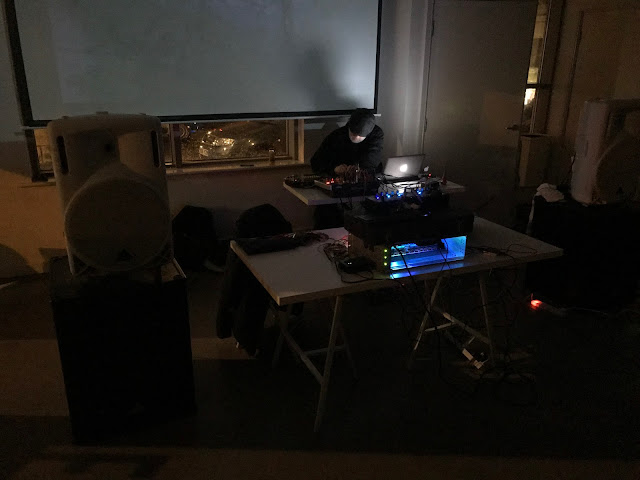 |
| Jez riley French performance at Fuse Art Space |
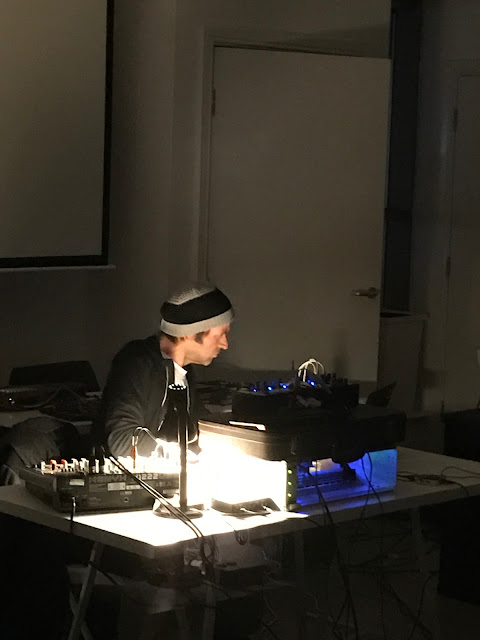 |
| My performance at Fuse Art Space, photo Jez riley French |
Following on from the gig Jez took me out on some active listening / recording field trips in the Yorkshire Dales. As well as taking some recordings, we spent a lot of the time doing active listening exercises. The process of active listening is a really important component of our practice, one that can be sometimes forgotten about in the midst of recording, editing, performing etc. Its a great way of just breathing out, soaking in all the sounds around, mentally readjusting/recalibrating, ear training and especially not focusing on just recording..
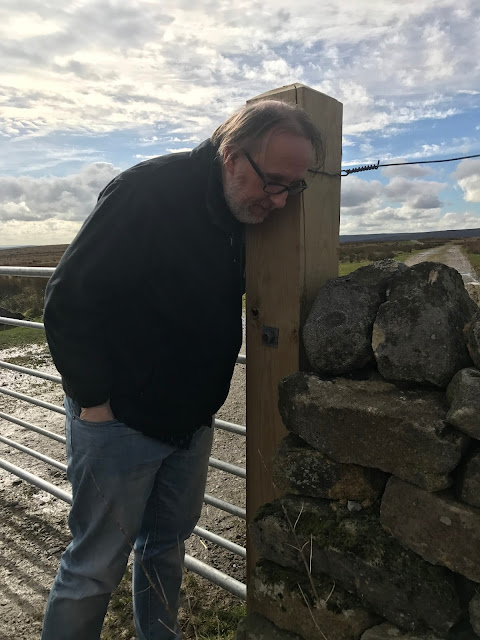 |
| Listening to wind through fence wires with Jez |
 |
| Grimwith Reservoir |
 |
| Grimwith Reservoir |
 |
| Listening to a metal gate with Jez |
 |
| Hydrophone recording with Jez at Pocklington Canal |
 |
| Me having a listen to the lock, photo Jez riley French |
 |
| Recording the lock gate at Pocklington Canal with JrF C-Series contact mics |
Another great spot we visited was Skerne Wetlands Nature Reserve =>
Recording railings in the rain at Hull =>
I was also very keen to record some of the industrial sounds of the area, and Jez identified a couple of great locations. The first place we visited was Bradshaw's Flour Mill, after walking around the mill and listening at various spots, we parked up in the car park and used Jez's DPA 4060's (
which you can buy from him direct!) hooked up to my Zoom F8.
We used a tried and trusted Jez technique of hanging them out of the car door window and very carefully putting the window up so the leads are just held lightly.. this allows for a good height while minimising any noise from ourselves as we listen inside the car.
 |
| Bradshaw's Flour Mill, East Yorkshire |
The next location we visited was Saltend Chemicals Park on the outskirts of Hull. There is a little dog walking road/track around the perimeter and we were able to find a good spot to park and hang the DPA's out the window.
I got a good mix of the chemical park sounds and some road traffic on wet ground, as well as the odd delicate spot of rain just audible over the industrial soundscape. Listening to this in the car on headphones as it was recorded was a very meditative experience..
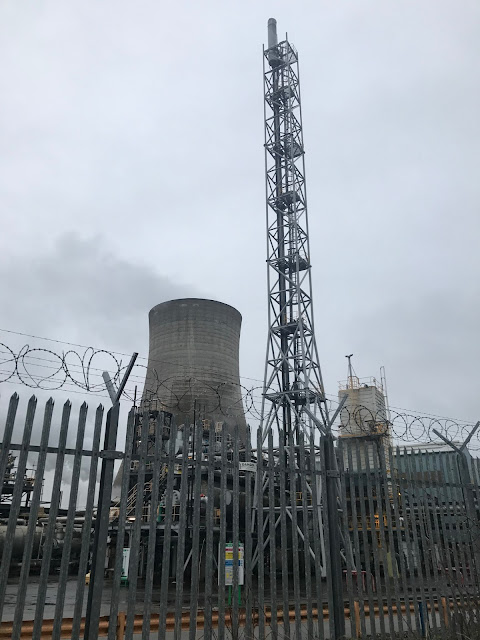 |
| Saltend Chemicals Park, Hull |
Folks out there interested in field recording should check out Jez's work and his range of contact mics, field recording gear and info available on his website => http://hydrophones.blogspot.com and also here.,
and the harpsichord in the university chapel.
I got to work straight away processing some of my Rainwire recordings through the VCS3. Its a quick and neat way of working with modular synthesis through the use of patch pins via a matrix which is something I really love.
 |
| On the VCS3, photo Rob Mackay |
Below are a few photo's of the performance of Open Field by Pauline Oliveros, performers for this were Jo Kennedy, Tallulah Vigars, David Burraston, Jez riley French & Rob Mackay =>
 |
| Jo Kennedy & Tallulah Vigars during the soundcheck |
 |
| All of us on stage during the performance |
Having spent 10 years playing classical piano until I was 16 I ended up with a great love of the harpsichord instead. So when I found out there was a nice little dual manual in the Chapel I managed to book a couple of hours recording time on it.
I borrowed a couple of Schoeps microphones and hooked them up to my Zoom F8, and with Rob Mackay's help we setup the mics on stands. Here is a brief excerpt of my little improvisation session =>
A few more pictures of the harpsichord session =>
After Hull I was off to Tokyo to round up the first 2 month overseas tour. Here I gave a performance at SuperDeluxe, as well as being invited to Roland Artist Liaison Centre to play on their synths!
 |
| Tetuzi Akiyama performing at SuperDeluxe |
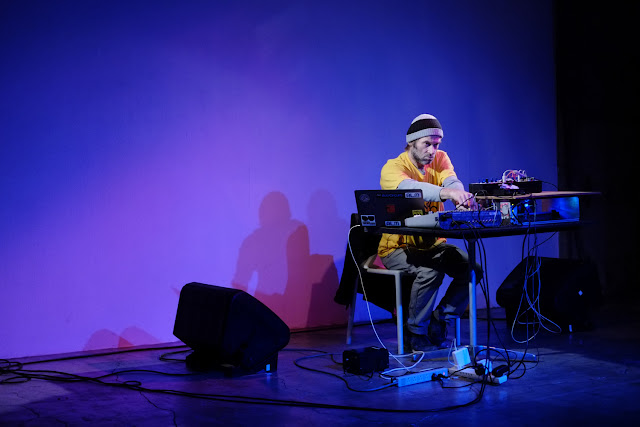 |
| Me performing at SuperDeluxe, photo Mike Kubeck |
I met up with Christian Moraga of Roland and he took me to a crazy synth shop, before we headed back to the Roland building..
 |
| Drooling over synths at FiveG, photo Christian Moraga |
After Japan it was back to NSW for a couple of months before my next overseas trip. I got the opportunity to make a few more field trips for Rainwire recordings at The Wired Lab for my Rainwire [Processed] installation =>
Back in my studio I did a little work on the PreenFM2, its an exciting little Open Source project for making a small, portable FM synthesizer with full microtuning. I decided to write a little Open Source programming tool for it in the Processing programming language using Farey Sequences. Full details of the program can be found in the PreenFM2 forum here and its available on github here ---- but briefly it is a tool to help with choosing the fundamental parameters of FM synthesis.
Another project I got on with was building some diode transformer ring modulators for processing my rainwire recordings for the upcoming installation. I've discussed how to make these in a previous blog post "
Modular Mortgage" which is a talk I gave at Unsound Adelaide. Here are a few pics, which include some ultra-rare military transformers: COIL C-161. As these are pretty heavy, I also made some others using smaller transformers for my next overseas trip..
Other activities for the Rainwire [Processed] material involved custom writing my own software for the Tiptop Z-DSP module via the Numberz programmer. A big shout of thanks to Chris Clepper at Tiptop for providing this equipment =>
I am hoping to make some of these Z-DSP programs available as pre-programmed cartridges in the near future, stay tuned! In the meantime you can get an ear for some of the programs on my limited edition 4xCDr NYZ - DSP TRX. This is a recent release on Psoma Psi Phi, where all the tracks are recorded from the direct outputs of the Z-DSP, with minimal post processing other than a slight bit of EQ and stereo placement. These recordings feature various DSP algorithms programmed in Spin FV-1 Assembler, mainly inspired by some of the classic Serge Paperface modules, but also some of my own inventions =>



 Richard was also very keen for me to be actively involved in the Cirklon and PreenFM2 communities, so he said "i might as well just give you one of each, and you can get on with it asap.." So he dug out a couple of bust ups, a Cirklon with a smashed off data encoder, and a chipped up PreenFM2, wowsers! thanks m8y! I got Finlay Shakespeare to fix the bust up encoder, and he did a great job on it. Here's a couple of pics of these setup in my studio =>
Richard was also very keen for me to be actively involved in the Cirklon and PreenFM2 communities, so he said "i might as well just give you one of each, and you can get on with it asap.." So he dug out a couple of bust ups, a Cirklon with a smashed off data encoder, and a chipped up PreenFM2, wowsers! thanks m8y! I got Finlay Shakespeare to fix the bust up encoder, and he did a great job on it. Here's a couple of pics of these setup in my studio => 







